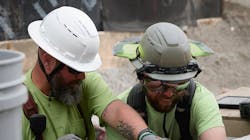How to Build Safety Compliance through PPE Choices
Key Highlights
In this article, you will learn:
- How to select effective PPE.
- Advancements in safety eyewear and helmets.
- How to increase worker engagement and education for PPE adoption.
- Proactive safety strategies for PPE.
Personal protective equipment (PPE) plays a vital role in preventing workplace injuries and maintaining productivity, especially in high-risk environments such as construction, where hazards are part of the daily routine. Effective protection transcends simply meeting compliance standards. Effective protection requires a thoughtful approach to selecting solutions that aligns with the actual risks workers face, evolving safety regulations, and the physical demands of the job.
Related safety content
- Keen fields a work shoe melding style with safety.
- ASSP consensus standard targets hazards and risks in construction and demolition.
- Tire safety emphasizes proper maintenance, inspection routines, and the use of safety equipment.
In today’s fast-paced and increasingly complex work environments, PPE must actively support the people who wear it. That means considering how safety equipment performs in real-world conditions, how it fits a diverse workforce, and how it impacts day-to-day tasks. When PPE is uncomfortable, restrictive, or ill-suited to the job, it becomes a barrier rather than a benefit. When workers don’t trust or understand their equipment, they are less likely to use it consistently.
The concept of “right-sizing” PPE means choosing equipment that not only meets regulatory requirements but also fits well, feels comfortable, and earns worker trust. As PPE technology continues to advance, contractors and safety managers have an opportunity to rethink how they approach protection: not just as a requirement, but as a strategic investment in safety, performance, and workforce well-being.
Close the gap between PPE availability and adoption
Despite the growing availability of advanced PPE, consistent adoption across job sites remains a challenge. Many workers still opt out of using protective equipment, not because it’s unavailable, but because it is uncomfortable, unfamiliar, or poorly suited to the task at hand. Discomfort, poor fit, and lack of understanding are among the most common barriers to consistent use.
This disconnect underscores the need for a more thoughtful approach, one that prioritizes comfort, education, and worker engagement alongside compliance. When workers understand the purpose of their PPE, feel confident in its effectiveness, and are involved in the selection process, adoption rates improve and safety outcomes can follow.
Advancements in PPE design and technology
Recent innovations in PPE are transforming how safety equipment performs on the job site, making it not only more protective, but also more comfortable, durable, and adaptable to real-world conditions. As job site hazards evolve, so too must the equipment designed to protect workers. Certain manufacturers are responding with solutions that go beyond compliance, prioritizing usability and long-term wearability to support both safety and productivity.
Take safety eyewear, for example. Modern designs are built with the realities of the job site in mind. Adjustable nose bridges and temples allow for a more personalized fit, accommodating a wide range of face shapes and sizes. Anti-fog coatings help maintain visibility in humid or high-exertion environments, while scratch-resistant coatings and gasketed designs enhance durability. Specialized lens options, such as tinted, mirrored, or polarized, further tailor protection to specific lighting conditions and hazards.
Similarly, head protection has evolved with the rise of Type 2 safety helmets. Construction workers face one of the highest rates of traumatic brain injuries (TBIs) across all industries, with falls accounting for nearly 70% of these incidents. Unlike traditional hard hats, which primarily protect against top-of-head impacts, Type 2 helmets are designed to guard against both top and lateral impacts, making them more effective in real-world scenarios where slips, trips, and falls are common. A recent study of helmet safety by Virginia Tech supports this.
Modern helmets also address more complex impact scenarios. Some manufacturers are engineering Type 2 helmets to protect against oblique impacts, those involving both linear and rotational forces, which are especially dangerous and often overlooked by traditional designs. These impacts require more advanced protection than what a standard hard hat or even a base line safety helmet can provide.
Together, these advancements reflect a broader shift in expectations: PPE is no longer just about meeting minimum requirements; it is about delivering safety equipment that workers can rely on, wear comfortably, and use consistently.
Proper fit plays a critical role in adoption, and PPE that adjusts to different body types and work conditions helps ensure that workers can perform tasks without distraction or discomfort. When safety equipment feels like a natural part of the uniform rather than an added burden, usage rates can increase, and safety outcomes improve.
Equally important is worker buy-in; employees are more likely to wear PPE when they understand its purpose and feel confident in its effectiveness. Involving workers in the selection process, offering training that connects safety equipment to real-world risks, and prioritizing comfort all contribute to a culture where safety is embraced, not enforced.
Safety standards are constantly evolving, and staying informed is essential for contractors and safety managers who want to maintain compliance and protect their teams. From updates to ANSI/ISEA helmet classifications to changes in eye protection ratings, regulations are becoming more specific and demanding, reflecting the growing complexity of job site hazards.
Rather than reacting to changes, proactive contractors are building strategies that anticipate regulatory shifts. This includes regularly reviewing safety guidelines, partnering with trusted PPE providers, and investing in solutions that meets or exceeds current standards. By staying ahead of the curve, teams can avoid costly delays, reduce liability, and ensure that workers are equipped with the most effective protection available.
About the Author
Austin Dorman
Austin Dorman is a group manager of product marketing for PPE at Milwaukee Tool.

